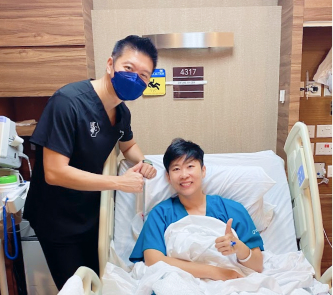Treat Ankle Sprains Promptly
My patient Gary is a very active young man who enjoyed most sporting activities, particularly basketball.
It was during a basketball training session in junior college when he first sprained his right ankle.
As ankle sprains are common in basketball, he did not seek medical attention then. And as soon as the initial pain and swelling subsided, he resumed his training.
However, his right ankle never felt the same after the injury. In the next few months, he would sprain it again and again while playing basketball. It got to a point where he sprained his right ankle every week.
A few months after he sprained his right ankle, he also sprained his left one and that ankle started to give way frequently too.
His ankle condition got worse when he entered national service. Not only were his ankles painful during prolonged walking or marching, but they also felt loose and had a tendency to give way, especially when he walked on uneven ground.
It was then that he saw his camp doctor and was subsequently referred to a sports physician, who started him on a course of physiotherapy.
Having an ankle sprain is one of the most common reasons for visiting an ankle doctor in Singapore or the emergency department. It accounts for up to 40 per cent of all sporting injuries, according to some reports, and is most commonly seen in those participating in activities such as basketball, soccer, running and ballet.
It usually occurs when the ankle "twists" or rolls inwards in an awkward manner, stretching or tearing the stabilising ligaments on the outer (lateral) side of the ankle, resulting in ankle instability.
In more severe cases, this can result in a broken bone or internal damage, such as cartilage injuries within the ankle.
Other than the obvious pain and swelling, the ankle may also be bruised and tender to touch.
A severe symptom is when one has difficulty bearing weight on the injured foot. In this case, medical attention should be sought as the sprain may be complicated by a fracture.
Most uncomplicated first-time ankle sprains get better with the Rice (Rest, Ice, Compression, Elevation) treatment. This will reduce the pain and swelling, following which a course of physiotherapy focusing on ankle strengthening and proprioception will allow most individuals to return to their previous level of activity, including sports.
However, about 20 to 30 per cent of those who suffered an ankle sprain may develop chronic ankle instability. This is characterised by repeated ankle sprains or a feeling of the ankle giving way, which was what happened to Gary.
This condition predisposes the ankle to further injuries such as cartilage damage and, over time, osteoarthritis of the ankle may occur.
Ankle cartilage injury and ankle arthritis can lead to chronic pain and restrict a person's mobility.
Therefore, those who find that they still cannot resume normal activities after a course of physiotherapy should consider surgical options to treat the damaged tissues and stabilise the ankle.
Injuries within the ankle can be treated arthroscopically (keyhole approach), whereby a camera is placed into the joint to assess the damage. The ankle can then be stabilised or "tightened", usually by repairing the ligaments that are torn via an open incision or, more recently, keyhole surgery.
Gary was referred to me for surgery, as physiotherapy did not help with his symptoms.
After an MRI scan of his right ankle showed a small area of cartilage damage as well as torn ligaments on the outside of the ankle, he had an ankle arthroscopy to treat the cartilage defect.
I used a bone marrow stimulation technique, where small holes are created in the ankle, to allow infiltration of stem cells at the site of the cartilage defect, thus kick-starting the cartilage healing process.
The torn ligaments were then repaired during the same surgery to stabilise his right ankle.
There are various other methods of treating ankle cartilage injury, each with its pros and cons. The choice depends on the size and depth of the area of damage, among other factors.
Gary started walking with protective boots two weeks after the surgery. Another four weeks later, he was wearing normal shoes. And three months after the surgery, he started jogging.
As he wanted to play basketball again, he decided to have his left ankle operated on as well. An MRI scan for this ankle showed torn ligaments, without any cartilage damage. I repaired the ligaments and, three months after that, he was back playing basketball.
Gary is a patient who was adequately treated for his chronic ankle instability. Many others with the same condition may be suffering in silence, as ankle sprains are common and frequently dismissed.
However, recurrent ankle sprains, if left untreated, can lead to chronic pain, cartilage damage and even arthritis later on in life. These unwanted complications can be prevented or minimised, if expert opinion is sought early.


| Tel. | : +65 6970 5905 |
| Fax | : +65 6970 5906 |
| Mobile | : +65 9898 7781 |
| : hello@bjc.sg, drkevinkoo@bjc.sg |
| Mon - FriMonday -Friday | : 8:30am to 5:30pm |
| Sat, Sun and PHSaturday, Sunday & PH | : Closed |
Well-being: Our Focus at
The Bone & Joint Centre.
We know that getting back to the activities you love is what truly matters. We are committed to providing high-quality, compassionate care to help you regain the ability to live life to the fullest.
Call us at 9898 7781 or fill out the form below and we will
get in touch as soon as possible.
| Tel. | : +65 6970 5905 |
| Fax | : +65 6970 5906 |
| Mobile | : +65 9898 7781 |
| : hello@bjc.sg, drkevinkoo@bjc.sg |
| Mon - FriMonday -Friday | : 8:30am to 5:30pm |
| Sat, Sun and PHSaturday, Sunday & PH | : Closed |





